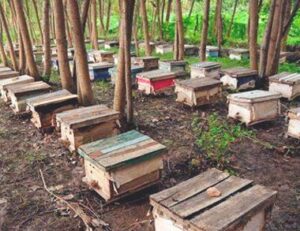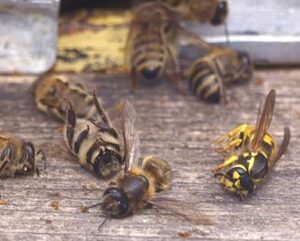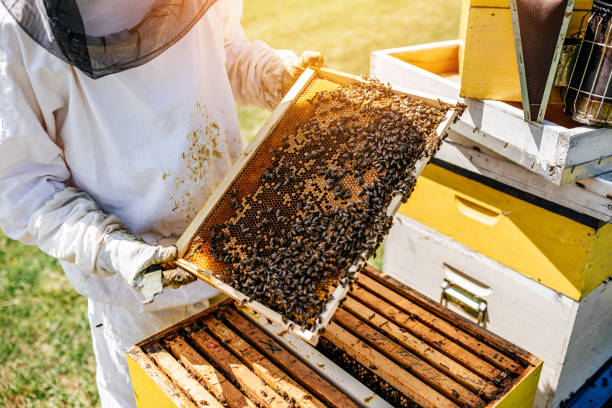Honey Bee Farming: India has been gathering honey from the forests for thousands of years, but honey bee farming has only been commercially successful for a short time. The hive stores honey made from flower juice that honey bees convert into honey.
Beekeeping in India is currently a profitable enterprise due to the increasing market demand for honey. Let’s talk about the products produced by Indian beekeepers. The two most important products produced from honey are honey wax and honey. To earn extra income, farmers can start this agro-based business. The business of making honey is a traditional occupation.
A number of industrial and domestic uses of honey are causing its demand to grow continuously in both the domestic and international markets. Pollination increases farming productivity and farmers earn money by starting this business. Our country India primarily relies on traditional agriculture. Beekeeping has become more popular among farmers after they experienced continuous losses with them.
Furthermore, beekeeping can be used as an essential input to maximize agricultural production. Pollen must be collected from other plants of the same species by outside agents, and bees are quick at accomplishing this. We will now explore honey bee farming in more detail.
The types of honey bees

There are typically three to twelve species of bees in each beehive, so a settlement could have more than three species. In this case, the queen bee is a fertile bee with the ability to give birth. Workers are sterilised bees that cannot give birth, while drone bees are males. Below is a list of some of the most notable bee species.
- Indian Hive Bees (Apis Cerana Indica)
- Rock Bees (Apis Dorsata)
- Little Bees (Apis Florea)
- European and Italian Bees (Apis Mellifera)
- Dammer Bee or Stingless Bee (Tetragonula Iridipennis)
Business Tips for Beekeepers
When starting honey bee cultivation, farmers need to keep certain things in mind. The following steps should be taken by the entrepreneur or farmer before starting this business.
-
You can begin this business by learning about bees and getting involved with them in the area where you plan to start. Get good training in honey bee farming.
-
Imagine that a farmer or entrepreneur has no previous experience working with bees. A local entrepreneur or farmer can provide all the information they need regarding the honey bee farming process in that case.
-
Entrepreneurs should then develop an effective plan for using the equipment and selling the products.
-
Set realistic goals when making a bee farming business plan. Start small and grow as your experience in honey business in India grows; you will be able to handle bigger projects as you gain more experience.
-
This project depends on the local circumstances as to what equipment can be used and what species of bees should be raised.
-
Honey bee farmers or entrepreneurs should identify a local agent in advance to sell their products. Honey can also be sold to ayurvedic pharmaceutical companies, bakeries, candy makers, and other businesses.
Read More : The Indian mustard farming industry: varieties, cultivation, and seed rate
Honey Bee Farming Business
The general society of agriculture-related firms has the opinion that anyone can start a business in beekeeping regardless of experience or knowledge, since it is an agro-based business. But that’s not true. A person who wants to start a beekeeping business must possess the necessary knowledge. We will now take a look at how someone can start his own business in beekeeping.
1. Beekeeping Training in India

A farmer who starts bee cultivation needs technical expertise and experience, as we have already discussed. It is therefore necessary for the farmer or entrepreneur to work with other farmers who are already engaged in beekeeping in the area for a few months before entering the field. An institute of repute can also provide you with a certificate for this business.
To learn more about this business as far as practice is necessary, entrepreneurs or farmers can contact their regional agriculture department or agricultural university. All this knowledge will be gained by an entrepreneur only after he has been trained by a local agriculture department or agricultural university.
2. Most suitable place for Bee Farming Business

It is important to select a dry place to start a honey business plan. The ripening of honey and the flying of bees are affected by high moisture levels. The site must have a natural or artificial source of water. A tree acts as a wind belt in colder climates. To provide shade, beehives can be placed under trees or in artificial arrangements.
The entrepreneur can keep beehives in the shade under trees if he chooses a site with an abundance of trees for a beekeeping project. Floras or pastures provide bees with pollen and honey. Honey Beekeeping may therefore be suitable in such a location since many plants produce pollen and honey.
Read More: The 7 best Indian sheep breeds and their details
3. Tools for Honey Bee Project

There may be different equipment requirements for beekeeping in India depending on the geographical conditions. Consequently, the entrepreneur can find out what tools will be suitable for him/her by contacting local beekeepers, although the following list of equipment is provided for your reference.
- Hive stand
- Bottom board
- Hive bodies
- Painting
- Smoker
- Hive tool
- Protective wear
- Frames and combs
- Queen excluder
- Inner cover
- Outer cover
- Plastic hive equipment
4. Manage Pollination Bee

Pollen and juice from plants are used by bees to make honey. To come from the plants, the beehives should be located near such a field. It is easy to obtain pollen and juice. In consequence, bee colonies should be established in areas with at least 10% flowering.
Honey farmers or entrepreneurs in India should also keep in mind that three colonies can be held per hectare if the bee species is Italian. Indian bees can be planted 5 colonies per hectare, on the other hand. The following crops benefit significantly from bee pollination, in addition.
-
Pollination among nuts and fruits benefits almonds, apples, apricots, peaches, strawberries, citrus, and lychees.
-
The following vegetables are grown in the area: cauliflower, carrots, cabbage, cilantro, cucumber, cantaloupe, onions, pumpkin, radishes, and turnips.
-
Mustard, safflower, niger, rapeseed, oilseed crops, sunflower, and other crops benefit from the honey bee farming project in India.
-
There are also fodder seed crops like lucerne and clover in this category
5. Keep Bees Free From Pests and Diseases

Farmers and entrepreneurs who intend to make good profits from honey bee farming should protect their stock and the organisms producing the honey. Entrepreneurs should therefore try to keep them free of pests and diseases. There are several types of pests that are common in beekeeping, including wax moths, ants, wasps, wax beetles, birds, tracheal mites, parasitic mites, Varroa destroyers, bee mites, and brood mites, among others.
Among the diseases found in the field include the European foulbrood disease, the American foulbrood disease, the Nosema disease, the Sacbrood disease (SBV), the Chalkbrood disease, the Thai sacbrood virus (TSBV), the Stonebrood disease, etc. To control specific pests and diseases, the farmer must take action in advance. Farmers can contact their local agriculture department to resolve these issues.
6. Bee Harvesting in India

The honey beekeeping project offers many famous products, including honey, bee venom, bee wax, royal jelly, propolis, and pollen. In order to harvest honey from old and top bar hives, the farmer must select a hive containing honey that is coated with bee wax and is located very near the outer edge of the nest. Honey Extractor Equipment extracts honey from the Super Hive part of the hive.
Cost and Profit Analysis of Honey Bee Farming Project
This cost report is based on 50 Bee colonies, and the estimated values are shown here as a reference. Things may have different values depending on where they are located and how many are available. There could be some additional costs associated with land and maintenance that have not been included in this estimate but are necessary for the project’s successful implementation.
Read More:India’s Potato Farming: Planting, Cultivation, and Harvesting
Assumptions of Bee Projects
-
No. of Beehives: 100
-
Cost of comb base sheet: Rs 700/kg
-
Sugar Price: 45/kg
-
Cost of nucleus box: Rs 1200 (Cerana) and Rs 2000 (Mellifera)
-
Cost of honey extractor: Rs 5000/ piece for Cerana and Rs 7000/piece for Mellifera
-
Hive stand cost: Rs 300
-
Labour cost per day: Rs 250
-
Cost of a Mellifera Bee colony: Rs 3500
-
Cost of a Cerana Bee colony: Rs 2500
Initial Capital Investment
| Material | Investment in Rs (Cerana) | Investment in Rs (Mellifera) |
| Cost of 100 Bee colonies | 2,50,000 | 3,50,000 |
| Cost of 50 nucleus box | 60,000 | 1,00,000 |
| Cost of the honey extractor | 5,000 | 7,000 |
| Cost of 100 Beehives | 1,00,000 | 2,00,000 |
| Cost of 600 ant wells | 12,000 | 12,000 |
| Cost of 150 feeder frames @ Rs 120/frame for Mellifera and Rs 100/ frame for Cerana | 15,000 | 18,000 |
| Cost of honey bee farming equipment (smoker, hive tool, swarm net, Bee veil, wire embedder, storage drums and other miscellaneous) | 10,000 | 16,000 |
| Cost of 150 hive stands | ||
| Cost of 200 Queen gates | 8,000 | – |
| Cost of 100 Queen Bee excluder sheet | – | 20,000 |
| Total cost | 4,60,000 | 7,23,000 |
Business Plan for Recurring Investments in Beekeeping
| Material and labour | Investment in Rs (Cerana) | Investment in Rs (Mellifera) |
| Cost of comb foundation sheet | 5,600 | 42,000 |
| Cost of sugar for feeding @ 200 kg for Mellifera and 100 kg for Cerana | 9,000 | 18,000 |
| Charges for survival and pollination | 20,000 | 50,000 |
| Labour charges for 300 days | 1,50,000 | 1,50,000 |
| Total cost | 1,84,600 | 2,60,000 |
Production Details
-
The amount of honey produced from Cerana is 1000 kilograms.
-
The amount of honey produced from Mellifera is 2500 kilograms.
-
Price per kg of honey bee boxes: Rs 200 (average)
-
An 8 kg jar of Cerana wax is produced.
-
Mellifera wax weighs 20 kg.
-
Beeswax cost/kg: Rs 300 (average)
-
For sale are 50 honey bee boxes at Rs 1,25,000 each (Rs 2500 per division) and Rs 1,75,000 each (Rs 3500 per division).
-
Bee farming income at Cerana is Rs (2,00,000 + 2400 + 1,25,000) = Rs 3,27,400.
-
There are 6,81,000 rupees in total in Mellifera honey bee farming income (5,00,000 + 6,000 + 1,75,000.)
-
Profits earned from working capital or recurring capital are as follows:
-
The profits of Cerana bee farming are calculated as follows: Earnings minus recurring capital (1,84,600 divided by 3,27,400 equals Rs 1,42,800)
-
In the case of Mellifera bee farming profits, total earnings minus recurring capital equals Rs 4,21,000.
Loans and Subsidies for Beekeeping Business

In association with NABARD, the National Bee Board (NBB) subsidizes Indian beekeepers and helps to employ women in these divisions. For more information on Bee Farming in India, please visit the NBB website or the nearest office.
Visit our blog section to learn more about different kinds of farming. For We have a news section where you can find information about bee farming subsidies and other government announcements. Aarug Agro APP allows you to receive regular updates as well.


